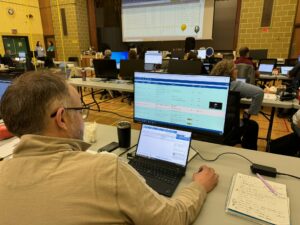What is Universal Design for Learning (UDL)?
The educational framework known as Universal Design for Learning (UDL) aims to provide equitable access to and effectiveness in learning for all, regardless of individual learning styles. My understanding of UDL emphasizes its flexibility through three main principles: multiple means of engagement, representation, and action and expression.
UDL fosters inclusive learning environments by accommodating various learning preferences. From this video, one of the uses they recommended for a UDL setting is multi-sensory lessons in both physical and digital classrooms. For example, to help a kid improve their letter recognition skills, a teacher could use felt or magnetic letters in a hands-on activity that engages both physical and visual senses (Alexandrov, 2024). Additionally, it’s important to incorporate various learning modalities rather than relying solely on text-based materials. By including a mix of text, audio, images, and videos, educators can address a broader range of learning preferences.
Ensuring Accessibility in Online Settings
Accessibility is crucial for equitable learning experiences. To make online learning accessible, several elements must be prioritized: accessible content, user-friendly design, accommodations, and testing accessibility. As emphasized in the readings, providing information in various formats (text, audio, video) aligns with the UDL principle of representation, ensuring learners can access materials in ways that suit them best.
Incorporating assistive technologies is essential for creating inclusive online environments. Tools such as screen readers, text-to-speech software, speech-to-text software, and closed captions help bridge accessibility gaps (Wylie, 2024). For example, screen readers convert digital text into speech, benefiting visually impaired learners, while closed captions provide access to audio and video content for those with hearing impairments.
Ethical Challenges of Educational Technology
Ethical Considerations in Digital Interactions
As a participant in online communities, I recognize my responsibility to respect others and maintain privacy. Being mindful of my online presence is essential; what I post can have lasting implications. In educational settings, academic integrity is paramount. The temptation to plagiarize or misuse AI tools is high, so it’s crucial to uphold honesty in my work.
Applying UDL and Accessibility Principles
 Reflecting on a recent learning experience during my co-op term at Vancouver Coastal Health, I noticed several strengths and areas for improvement regarding UDL and accessibility. Our training on an electronic health information system included engaging online modules that promoted self-assessment and reflection before the classroom session. This approach effectively supported engagement.
Reflecting on a recent learning experience during my co-op term at Vancouver Coastal Health, I noticed several strengths and areas for improvement regarding UDL and accessibility. Our training on an electronic health information system included engaging online modules that promoted self-assessment and reflection before the classroom session. This approach effectively supported engagement.
However, challenges arose in the areas of representation. While I was familiar with much of the language, several classmates struggled to grasp the terminology used, indicating a need for additional background information. Furthermore, the instructor’s focus on time led to rapid slide transitions, making it difficult for some participants to keep up.
In terms of action and expression, we were encouraged to provide feedback and ask questions, enhancing our learning experience. Overall, while the training somewhat adhered to UDL principles, improving background knowledge accessibility and pacing could significantly enhance support for all learners.
References:
Alexandrov, M. (2024, February 7). Bring these 5 multisensory teaching strategies home. ParentPowered – Evidence-Based Family Engagement. https://parentpowered.com/blog/science-of-reading/multisensory-teaching/#:~:text=Multisensory%20teaching%20refers%20to%20methods,child%20build%20their%20letter%20knowledge.
Tomaszewski, J. (2011). Lesson Plan Booster: Digital Literacy and Online Ethics. Education World. https://www.educationworld.com/a_lesson/lesson-plan-booster/cyber-ethics.shtml
Wylie, N. (2024). Accessible Learning: 10 Ways to Create a Better Learning Experience. Action @ Work. https://blog.cathy-moore.com/accessible-learning/#gref